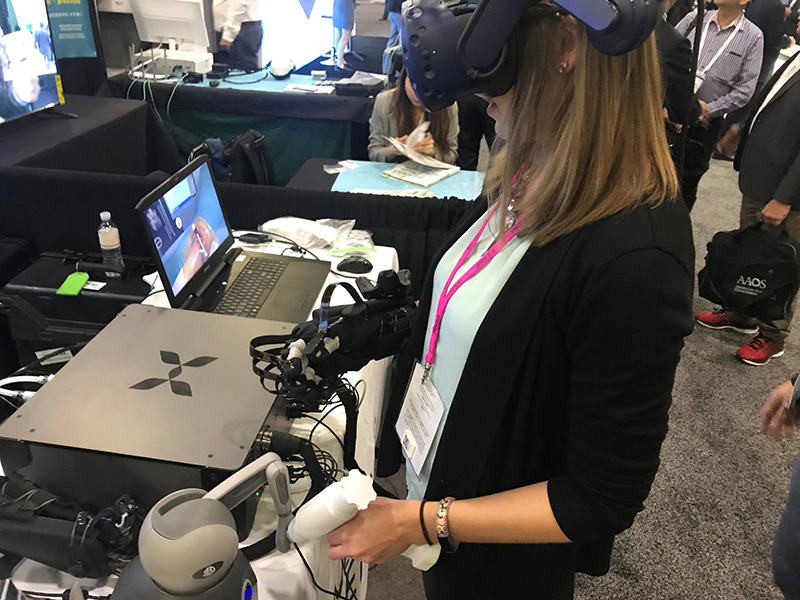At the American Academy of Orthopaedic Surgeons (AAOS) annual meeting 2019, I got the opportunity to try my hand at surgery—in virtual reality, of course.
There I met with FundamentalVR, a company that delivers innovative VR surgical simulations with haptic feedback. This haptic feedback focuses on providing the most realistic training within different medical simulations. To give you an idea, I could literally feel the bone and flesh I was “digging” into.
“Previously, to have meaningful simulation with haptics, it would cost hundreds of thousands of dollars,” said CoFounder of FundamentalVR Chris Scattergood. “You see these big kits in hospitals, and it costs a fortune to maintain.”
What Fundamental Surgery has done is bring together easy-to-use haptic units and write a great piece of software overtop of it. Scattergood said by allowing hospitals and universities to subscribe to Fundamental Surgery’s platform and offer different VR procedures and content, they have given hospitals a really revolutionary low-cost simulation. The system, known as the Surgical Haptic Intelligence Engine (SHIE), mimics medical tools and tissue variants with accurate resistance.
“We want this to be in every hospital in America,” said Scattergood. “That’s what we’re doing here. What we’re about is haptics, a low-cost platform, and safety and compliance.”
Scattergood said the company creates a dashboard for everyone who uses the system at a university or hospital, and individual trainees log in, record their performance, and then residency directors can see what the trainees are doing.
“It gives hospitals, for the first time, an online platform for assessment,” Scattergood said.
Because one of the key elements, aside from low-cost, that Fundamental Surgery focused on was haptics, Fundamental Surgery collaborated with HaptX.
“We believe that haptic touch and the ability to feel is key, because a lot of VR simulations don’t have that. They just use game control,” said Scattergood. “The haptics themselves and the art of it is important.”
Sharing the booth with Fundamental Surgery was HaptX, where HaptX featured HaptX Gloves. The joint initiative demonstrated the flexbility of FundamentalVR’s platform to integrate haptic sensations.
“We’re doing a collaboration project with them to show how haptics will be used in the future,” said Scattergood. “This isn’t something you can buy right now, but in a year there will be commercial products coming out. What HaptX is doing is you can actually feel inside the patient, and you can feel the boney bits. It’s really cool.”
After trying out FundamentalVR’s system, I moved on to using HaptX’s glove, where I performed different medical procedures while wearing the glove. Customer support engineer for HaptX, Tyler Hushing, took me through the steps in navigating the glove and device.

With 130 points of tactile feedback, you can feel everything you touch in the virtual world. Hushing said the corresponding part of the hand that is touching an object gets displaced, and if you push down it will feel like you’re physically touching the object. The glove is powered by microfluidic technology and each of the tactile actuators press the user’s skin. Additionally, a force feedback exoskeleton applies up to four pounds of force per finger, which enhances the perception of shape and rigidity.
“We spent a lot of time researching how to get realistic touch,” said Hushing. “A lot of other companies do vibrotactile…so when you touch something, it will vibrate your fingertip to symbolize you’re touching something. We’re doing realistic tactile feedback. We did a lot of research and finally settled on having to do skin displacement if we want people to fully feel what’s in the virtual world.”
In terms of using this glove in the training space, Hushing said there are numerous benefits.
“In the training space we hear a lot about negative training, which is where you’re training the right task, but you’re training the wrong muscle,” said Hushing. “We are valued to actually train your hands and train your brain to remember these steps by using your hands exactly how you would use them when you’re doing the actual task.”
From practicing surgery in VR for training purposes and feeling the bone you’re drilling into, Scattergood feels confident that this means of technology will continue to pave the way for future medical training and hospital procedures.
“We know we’re in the right place,” Scattergood said.




